Last updated on February 23rd, 2024 at 01:41 pm
Diabetes sufferers must not be confused about what exercise will work and what will not. Here’s a dummies guide to exercising for diabetes that you must start from today. Resistance exercise is a crucial component to keep the body healthy and fit. It is commonly performed by bodybuilders to build their muscles and body. Resistance exercise is also termed strength training as it helps to improve and maintain muscle strength.
However, it is also recommended for a young person with diabetes as research has found its beneficial effect on diabetes type 2. Resistance training, when performed in the gym, uses complicated gym equipment. Fortunately, it can also be done at home by using a simple dumbbell, resistance band and our body weight as resistance.
- Guide to exercising for diabetes
- Types of exercises for diabetes
- Effect of exercise on sugar level
- Resistance Exercises for diabetes video
- #1 Hip & thigh muscle strength training
- #2 Chest muscle exercise for diabetes type 2
- #3 Upper back muscle
- #4 Mid back muscle
- #5 Resistance training for shoulder muscle to lower blood sugar level
- #6 Shoulder muscle strength exercise
- #7 Upper arm front muscle
- #8 Upper arm back
- #9 Exercise for front leg muscle
- #10 Back leg muscle exercising for diabetes
- #11 Resistance exercise for low back muscle
- #12 Abdominal muscle exercise for diabetics
- Exercise recommendations
- Diabetes video series
Guide to exercising for diabetes
This article will focus on resistance exercises using two dumbbells, each weighing 2 kg and our body weight. We will cover all major muscle groups or upper limbs, trunk, abdomen and lower limbs. But before we proceed, I recommend watching a video on the importance of exercise in reducing sugar levels and the different types of exercise for type-2 diabetes. The video is in Hindi, but English subtitles are also available.
Types of exercises for diabetes
Effect of exercise on sugar level
Resistance Exercises for diabetes video
Diabetes is an independent risk factor for low muscular strength and accelerated decline in muscle strength and functional status1.
- The health benefits of resistance training for all adults include improvements in muscle mass, body composition, strength, physical function, mental health, bone mineral density, insulin sensitivity, blood pressure, lipid profiles, and cardiovascular health.
- Resistance exercise can assist in minimizing the risk of exercise-induced hypoglycemia in type 1 diabetes.
- When resistance and aerobic exercise are undertaken in one exercise session, performing resistance exercise first results in less hypoglycemia than when aerobic exercise is performed first.
#1 Hip & thigh muscle strength training
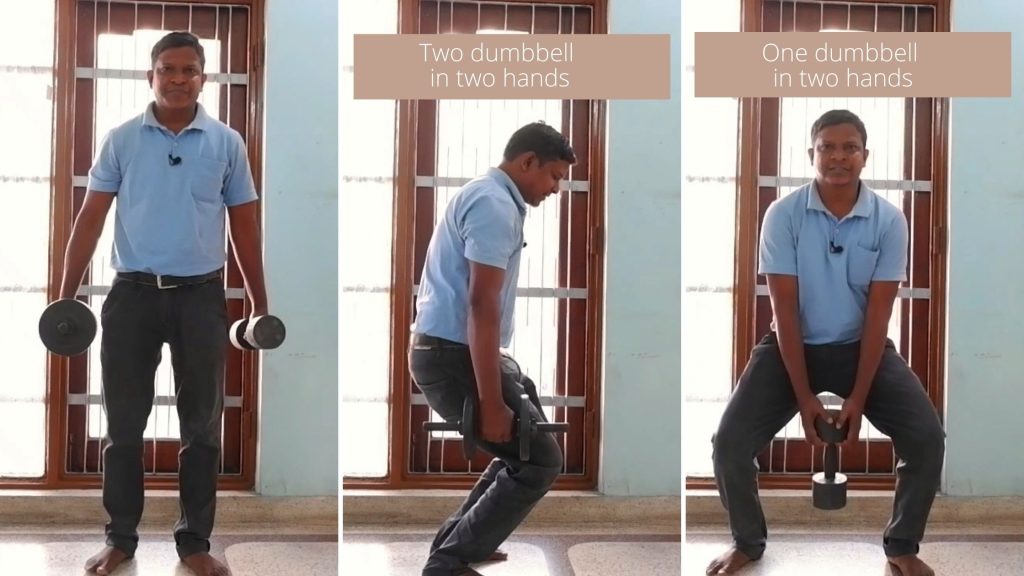
The exercise involves resistance training for the hip and thigh muscles. You will need two dumbbells for this exercise. You can choose the weight of the dumbbells depending on your comfort level.
- To start, hold the dumbbells in both hands. Stand with your feet shoulder-width apart and keep your back straight.
- Then, slowly bend your knees and lower your body into a semi-squat position. Make sure to keep your knees aligned with your toes and your thighs parallel to the ground.
- Pause for a second and then slowly return to the starting position.
- Repeat this movement for 10 to 15 repetitions.
If you have only one dumbbell or cannot hold it with both hands, you can still do this exercise with a slight modification.
- First, stand with your feet shoulder-width apart and hold one dumbbell between your legs. Make sure to have the dumbbell with both hands.
- Then, lower your body into a semi-squat position.
- Pause for a second and then slowly return to the starting position.
- Repeat this movement for 10 to 15 repetitions.
#2 Chest muscle exercise for diabetes type 2
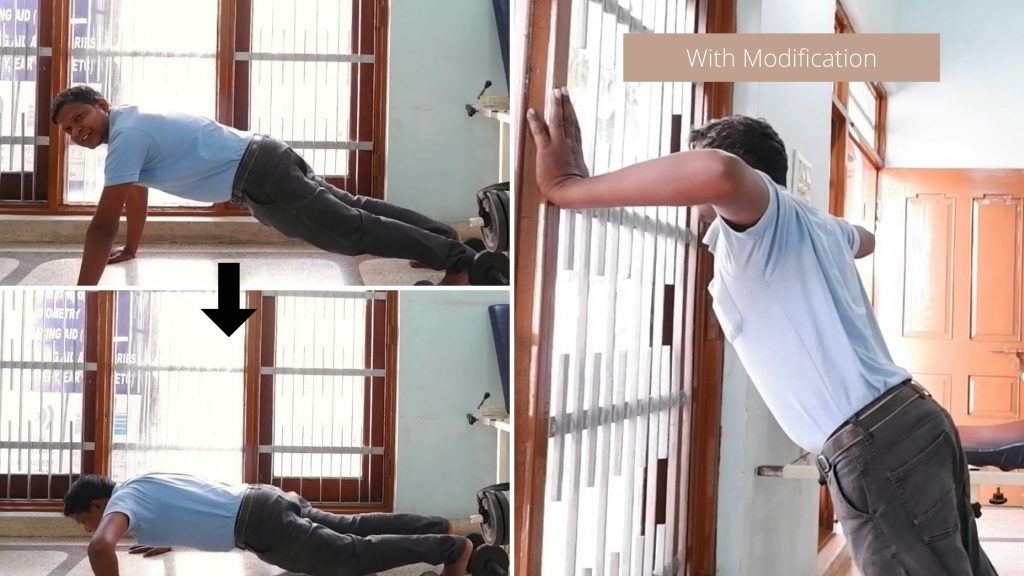
Dips are considered one of the best exercises to target your chest muscles effectively. Here’s how you can perform this exercise:
- Begin by lying on your tummy with your body straight and supported over your hands and toes.
- Place your hands slightly wider than your shoulders, and keep your arms straight.
- Now, lift your body off the ground by extending your arms fully. This is your starting position.
- Slowly lower your body towards the ground by bending your elbows. Keep your torso upright and your elbows close to your body.
- Once your arms are bent at a 90-degree angle, push yourself back up to the starting position by extending your arms.
- Repeat the movement for the desired number of reps.
If you’re a young person, you can perform dips/push-ups on the ground. However, older individuals may find doing this exercise on the ground challenging. In that case, you can modify the exercise by inclining yourself against a wall. This will reduce the weight you have to lift and make the exercise easier. You can effectively build your chest, triceps, and shoulder muscles by performing dips. Incorporate this exercise into your workout routine for a well-rounded upper-body workout.
#3 Upper back muscle
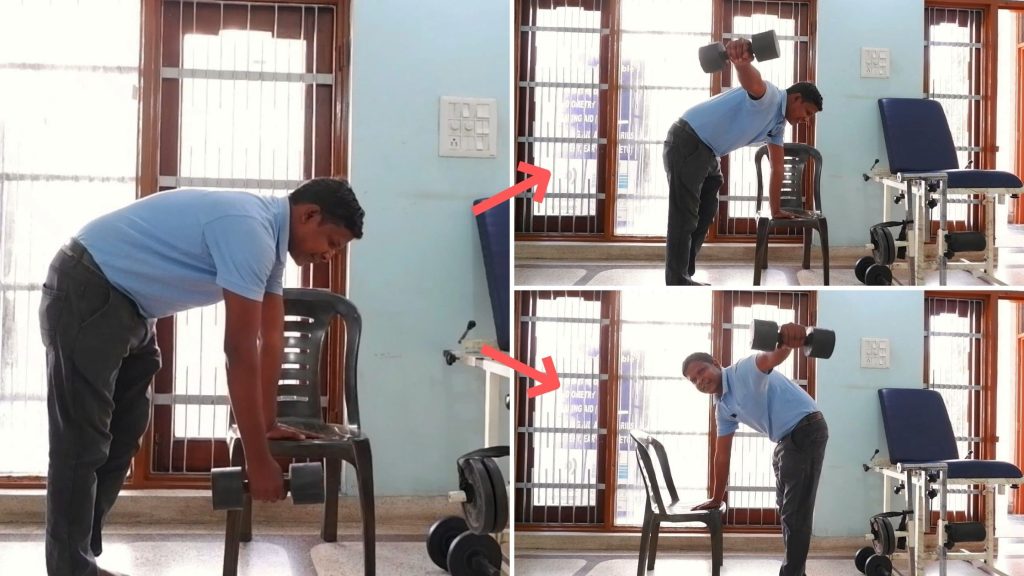
You will need a dumbbell and a chair to perform the exercise for your upper back muscles.
- Begin by standing beside the chair and holding the dumbbell in one hand. If the chair is on your left side, have the dumbbell on the right.
- Now, lean forward and support yourself by placing your other hand beside the chair. Your feet should be shoulder-width apart, and let the arms holding the dumbbells hang straight down.
- Keeping your arm straight, raise the dumbbell from the body to the shoulder level so that the arm is parallel to the ground, as shown in the figure.
- Pause for a second at the top of the movement and then slowly lower the dumbbell back down to the starting position.
- Repeat this movement for several reps, then switch to the other side.
- To perform the exercise on the other side, stand on the opposite side of the chair and repeat the same movement.
#4 Mid back muscle
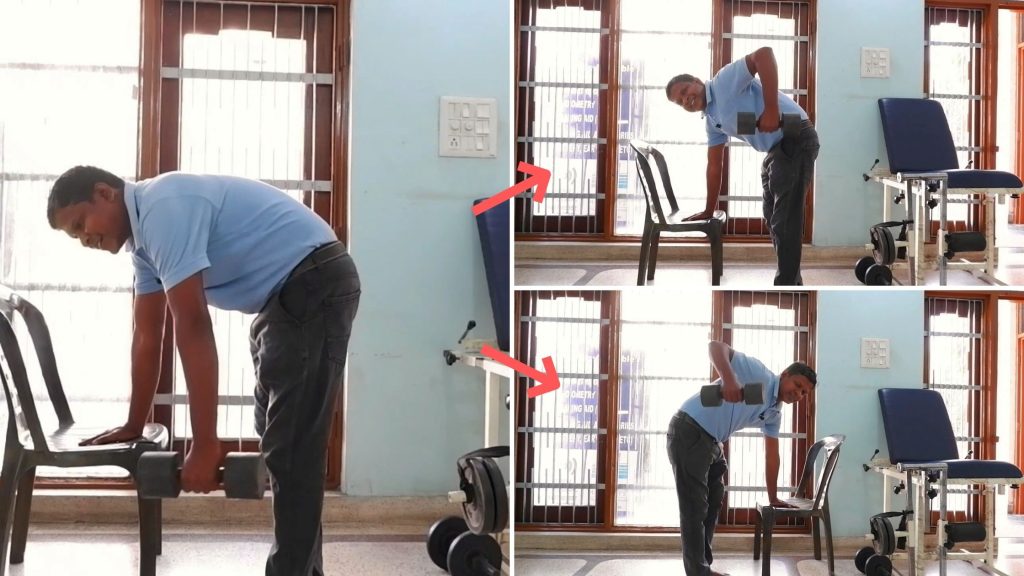
To work on your mid-back muscles, you can perform an exercise that involves lifting dumbbells to shoulder level with your elbows bent. The starting position will be similar to the previous exercise, i.e. lean forward and support yourself by resting one hand, keeping your arm straight on the chair beside you. Hold a dumbbell on the opposite hand and let the arm hang straight downwards.
- In this position, bend your elbows and lift the dumbbells to shoulder level. Keep your elbows close to your body as you lift the weights.
- Hold the dumbbells at shoulder level for a second or two, then lower them back to the starting position.
- Repeat this exercise for a few sets, and rest between each set for a minute or two. Using a weight that is challenging but manageable for you is essential.
- As you progress, you can gradually increase the weight of the dumbbells to continue challenging your muscles.
#5 Resistance training for shoulder muscle to lower blood sugar level
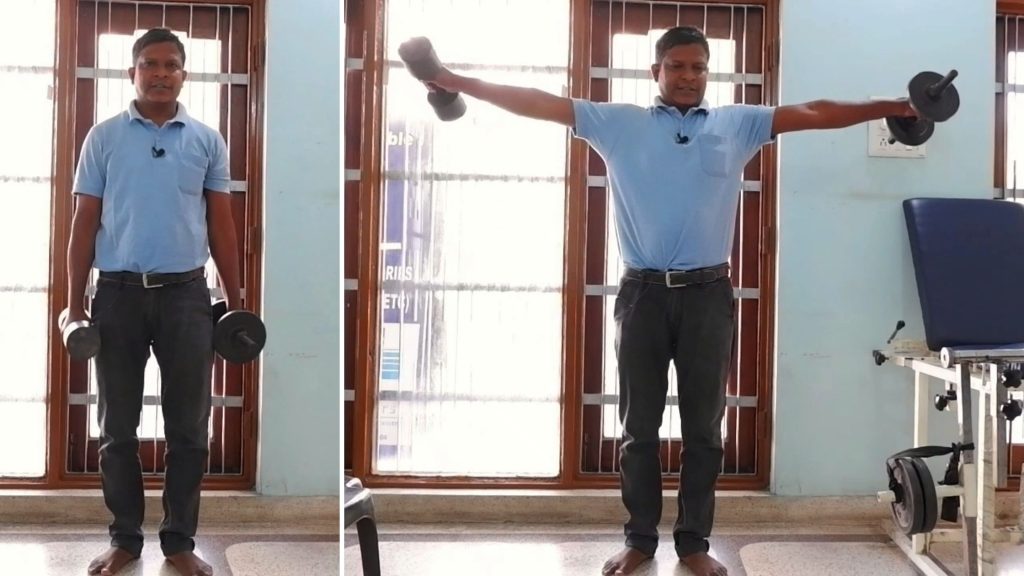
Our next exercise is aimed at the shoulder joint. This exercise is performed in a standing position.
- So stand straight and hold the dumbbell in both hands at your sides, with palms facing inwards.
- To target the muscles around your shoulder, raise both arms straight to the side, keeping them level with your shoulder.
- Then, lower the arm back down to your side and repeat the same motion with your other arm.
- Aim to do three sets of 12 to 15 repetitions for each arm.
- If you want to perform this exercise in sitting, you can do it by sitting straight on the chair. Raise your arm straight to the side, keeping it level with your shoulder, and then lower it back down to your side.
This exercise will help strengthen the muscles around your shoulders, improving your posture and overall upper body strength.
#6 Shoulder muscle strength exercise
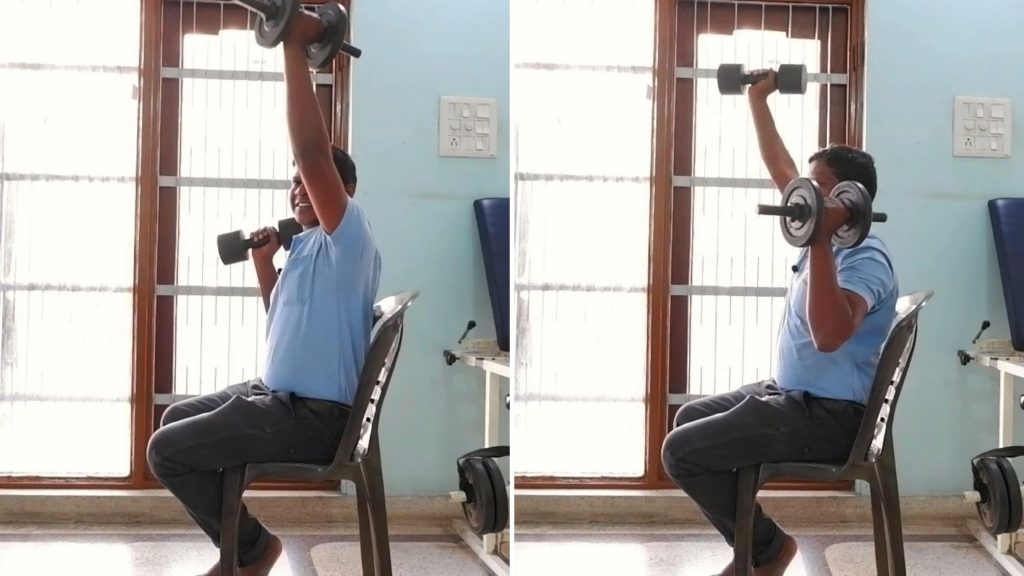
This exercise is designed to strengthen the muscles in and around the shoulder joint. For this exercise:
- Sit in the chair and hold the dumbbell in both hands, with the elbow bent upward and the dumbbell beside your ear.
- Slowly raise the dumbbell overhead from this starting position until your arm is fully extended.
- Hold the dumbbell in this position momentarily, then slowly lower it back to the starting position.
- Repeat this movement with the other arm, raising and lowering the dumbbell slowly and with control.
- Alternate raising and lowering the dumbbell with each arm for the recommended repetitions.
#7 Upper arm front muscle
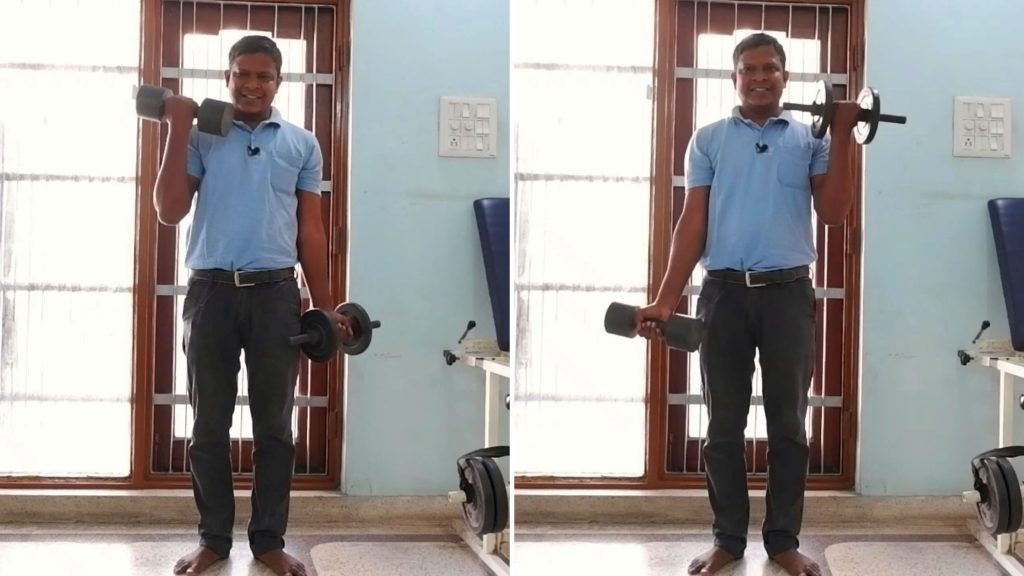
This exercise is specifically targeted towards the upper arm, specifically the biceps muscle located on the front side of the arm. It’s a widespread exercise and is well-known among fitness enthusiasts.
- Start by standing up straight with your feet shoulder-width apart and your arms hanging down by your sides, each hand holding a dumbbell with your palms facing forward. Keep your elbows close to your torso, and your shoulders relaxed.
- Now, slowly lift the dumbbell towards your shoulder by flexing the elbow joint, keeping your palm facing upwards.
- Pause momentarily at the top of the movement before slowly lowering the weight to the starting position.
- Repeat this movement with the other arm and continue alternating arms until you have completed the desired number of repetitions.
#8 Upper arm back
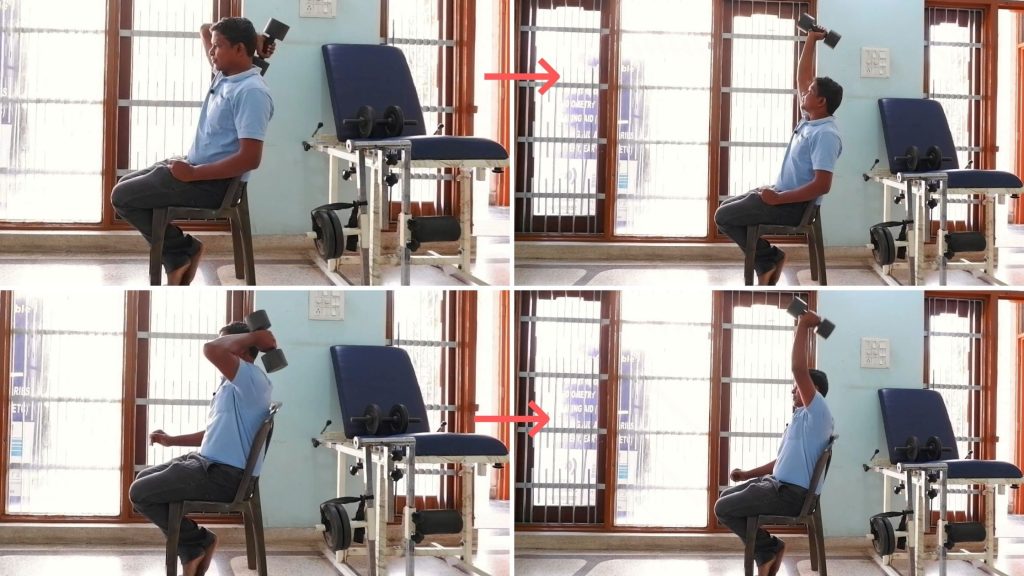
This exercise, called the triceps extension, targets the muscles behind your upper arms, also known as the triceps. For best results, it is recommended to perform it while sitting down.
- First, grab a dumbbell with one hand and raise your shoulder to the ear level.
- Then, bend your elbow behind you, keeping your elbow close to your head and your wrist straight. Make sure to hold the dumbbell firmly with your hand.
- Next, slowly straighten your elbow by raising the dumbbell vertically until your arm is fully extended. While doing so, it’s essential to keep your shoulder stable and avoid any jerky movements.
- Pause momentarily at the top of the movement, then slowly lower the dumbbell back to the starting position, bending your elbow again.
- Complete 5 repetitions on one side before switching to the other side.
#9 Exercise for front leg muscle
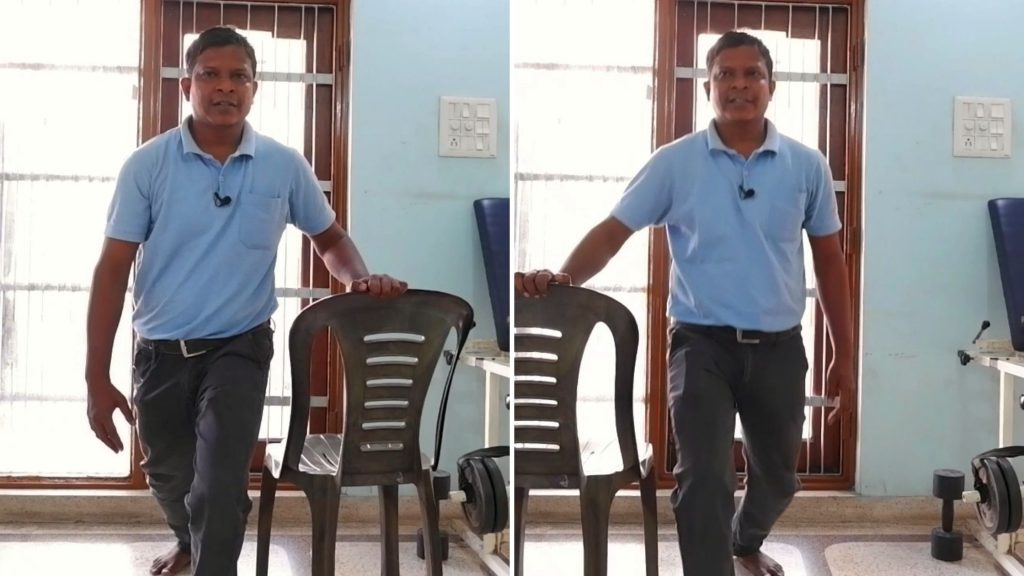
You can start by positioning a chair next to you to perform this exercise. For example, to exercise the left leg, keep the chair to the left side and hold it with the left hand. Next, lift your left foot off the ground and place it a few inches in front of you to ensure that your toes are pointing forward. This will be your starting position.
- Now, lean your body forward while keeping your back straight and your core engaged. Keep your left foot firmly planted on the ground throughout the exercise. Slowly lower your body by bending your left knee.
- Once you reach the desired depth, push through your left foot and return to the starting position.
- Repeat this movement for 10 repetitions.
- After completing the set on your left leg, shift the chair to the other side and repeat the same with your right leg.
This exercise is great for strengthening the muscles in the front of your legs and can be done anywhere with a sturdy chair to hold onto.
#10 Back leg muscle exercising for diabetes
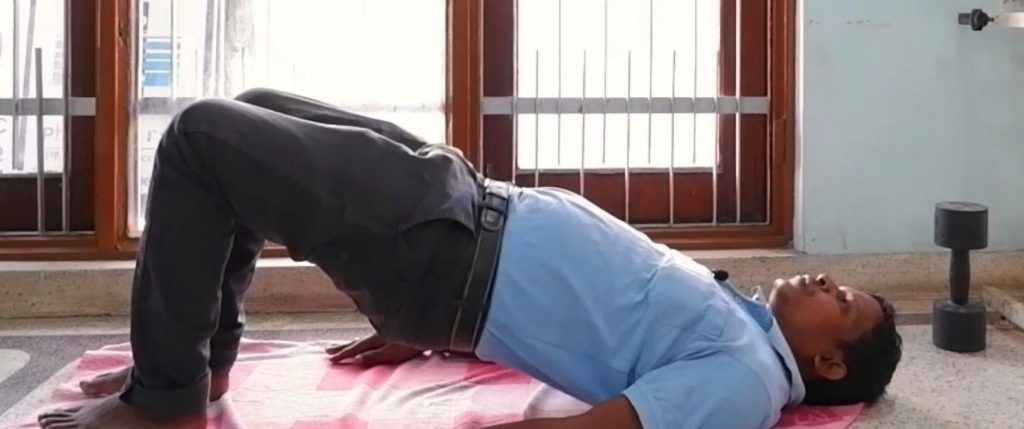
To perform this exercise, you will need a mat or a comfortable surface to lie on.
- So, start by lying flat on your back with your arms at your sides and your knees bent.
- Next, lift your hips off the ground while keeping your feet flat on the floor. Your shoulders, hips, and knees should form a straight line.
- Hold this position for a few seconds, then lower your hips.
- Repeat this movement for a total of 10-12 repetitions.
- This exercise targets both the muscles behind the leg and the lower back muscles of the waist, making it a great addition to any workout routine.
#11 Resistance exercise for low back muscle

To perform the lower back muscle exercise, you first need to position yourself in a quadruped position, which means getting down on your hands and knees. Once you are in this position:
- Lift one leg off the ground and straighten it completely, ensuring your knee is straightened. This will engage your lower back muscles.
- Hold this position for a few seconds, then slowly lower your leg to the ground.
- Repeat this for 10 repetitions.
- Repeat this movement with your other leg.
It’s essential to keep your back straight and engage your core throughout the exercise to avoid strain on your lower back. You can also try to raise your arm opposite to the leg you’re lifting to add an extra challenge and engage your core muscles even further. Remember to take slow and controlled movements to maximize the effectiveness of the exercise.
Likewise, alternate on both legs one by one for recommended repetition. If you have a bulky hip, you should also focus on burning fat around the hip by following the 6 Easy Hip Fat Reduction Exercises.
#12 Abdominal muscle exercise for diabetics
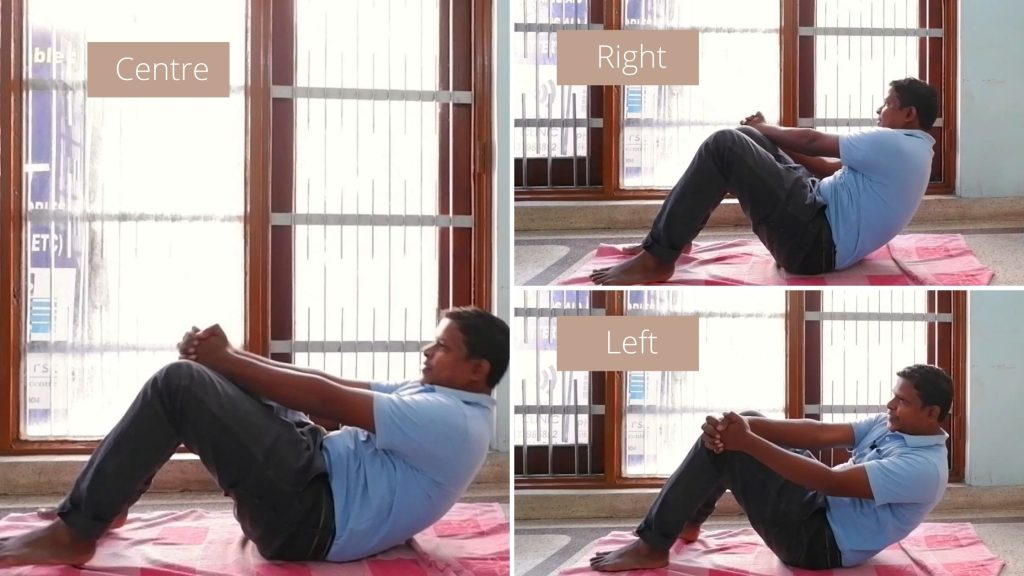
The exercise that we will be discussing is known as the abdominal crunch. This exercise is considered one of the best for type 2 diabetes as it helps strengthen the abdominal muscles and aids in burning abdominal fat. This exercise can be performed anywhere and does not require any equipment.
To perform this exercise, you need to lie on your back with both knees bent and your feet flat on the ground. Place your hands behind your head or cross them over your chest. Make sure your elbows are pointing outwards.
- Now, engage your core muscles and lift your head, neck, and shoulders off the ground. Exhale as you lift yourself. Your lower back should remain in contact with the floor.
- Hold the position for a few seconds and then slowly lower yourself back down to the starting position. Inhale as you lower yourself back down.
- Repeat this movement for the recommended number of repetitions.
- To increase the intensity of the exercise, you can alternatively lift your chest in the centre, left, and right directions.
Exercise recommendations
So, in this way, you have to cover almost all the muscles of the body. Now, how do you have to do this exercise? What about the sets and repetitions?
Let me explain it to you:
- When you first plan to start with exercises, we recommend you choose any 6 to 8 exercises from the list of exercises in this article.
- Now, you have to perform these exercises two days a week. Choose any two days, like Wednesday, Thursday, Friday, or whatever you feel is convenient; choose two days and do these exercises six exercises in 2-2 sets, okay?
Regarding the number of repetitions, you must do at least eight repetitions in a set. Let me simplify it with an example: let’s take the 5th number exercise, the shoulder exercise. Lift the dumbbell to the shoulder level 8 times, which becomes 8 repetitions in one set. Similarly, you have to do two sets, okay, so you have to do two sets of all these 6 exercises, and there should be eight repetitions, and in between one set, you can rest for 1 to 2 minutes, okay? Will you remember it?
Then, as you do this for two to three weeks, four weeks or even one month, you can progress to the next stage, in which you have to choose a minimum of 12 exercises from the list. Do these exercises three days a week, okay, in a day, you have to do three sets. Unlike in the previous one, in which you have to do two sets, you have to do three sets, and in one set, you have to do 10 to 12 repetitions.
Diabetes video series
I have prepared a five-episode diabetes video series to guide you through the basics of diabetes, why exercise is essential and the step-by-step progression to exercises. All the exercises discussed here are screengrabs of this video. I’m sharing the first episode; I recommend watching each for the best guidance. Research suggests that global diabetes cases are on pace to soar to 1.3 billion people in the next 3 decades . One of the major reasons could be our nature of work, a profession that is increasingly becoming stagnant. But, the exercises and being active is way out. With this, I wish you all a good recovery from diabetes.
Keep Reading: What Vitamin B12 Good For? Six B12 Deficiency Symptoms
The author is a physiotherapist who has been practising for the last 17 years. He holds a Bachelor's in Physiotherapy (BPT) from SVNIRTAR (Swami Vivekananda National Institute of Rehabilitation and Research), one of the prestigious physiotherapy schools in India.
Whatever he learns dealing with his patient, he shares it with the world through blogs and e-books. He also owns a YouTube channel, "Sunit Physiotherapist" with over 8 lakh active subscribers. Here, he shares everything he gets to learn serving the patient.
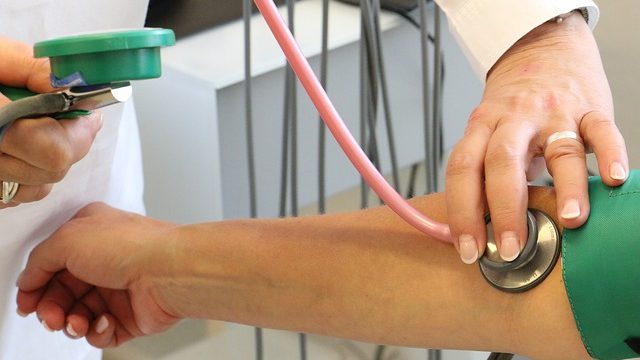
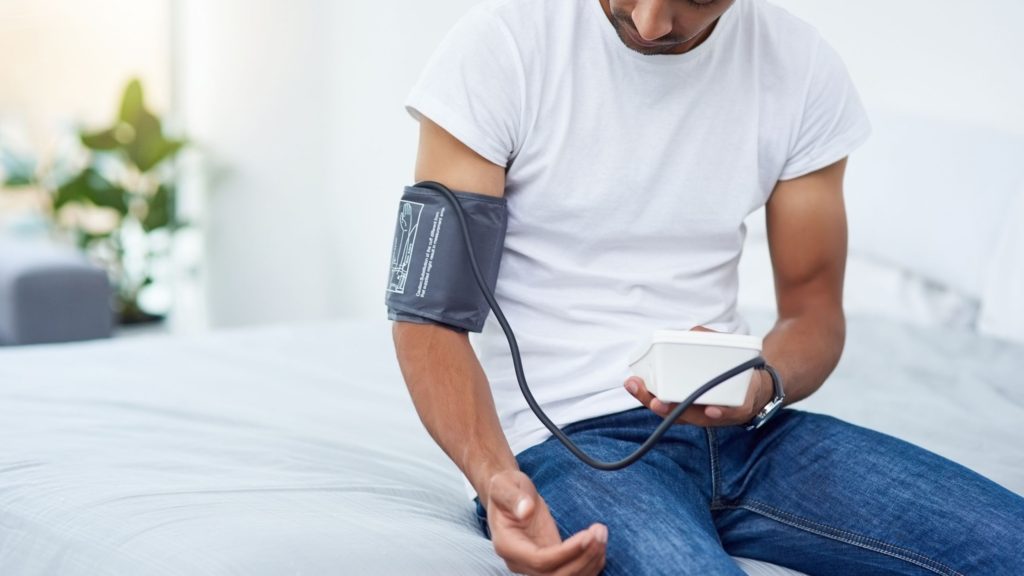

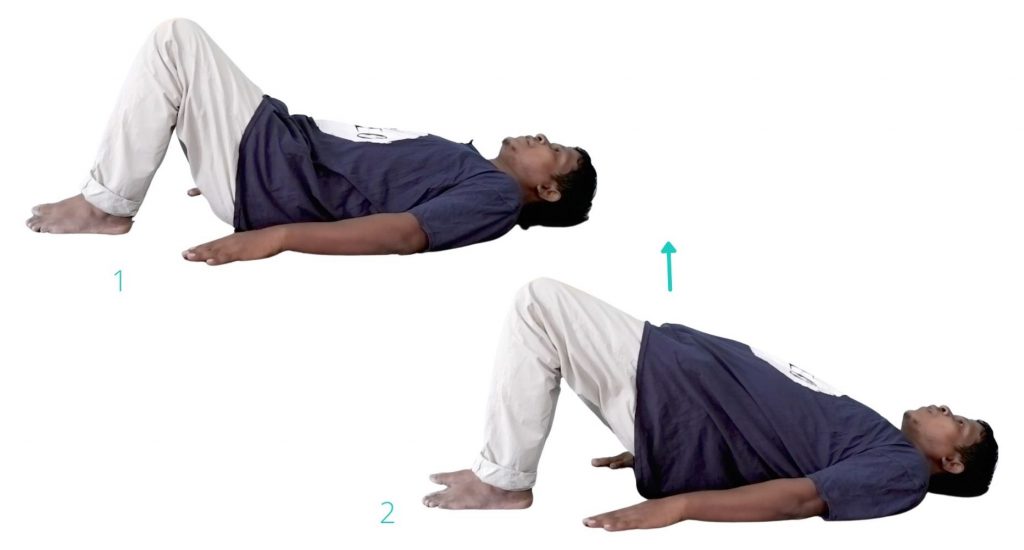


I have read article on this blog which is very useful for diabetic patients.
nice information